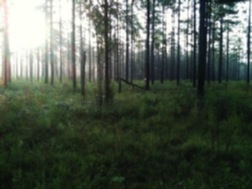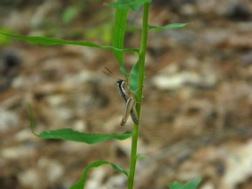Updated: 01/04/2025
Predicting herbivore intensity in disturbed habitats is not as easy as it might seem… Results were a bit surprising in “Land-use legacies and present fire regimes interact to mediate herbivory by altering the neighboring plant community” by Philip G. Hahn and John L. Orrock. Below is the author’s summary of the study:
The southeastern United States was once teaming with biodiversity in the sprawling, open pine savannas that stretched from Virginia to Texas. Post-settlement, these biodiversity hotspots were quickly reduced to less than 3% of their original extent, largely through conversion to agriculture and fire suppression. More recently, many agricultural fields have been abandoned and replanted with pine trees. Although these degraded woodlands harbor low levels of biodiversity, they offer tremendous potential to restore lost species. Particularly, ecologists know very little about interactions among plants and insects in these degraded ecosystems. Hypothetically, insect herbivores, such as grasshoppers, could be suppressing plant diversity in these post-agricultural woodlands by preferentially consuming more palatable remnant wildflowers that attempt to reestablish.

The sun rises over a rare remnant longleaf pine savanna, fueling a motley array of biological interactions.
We tested this idea by transplanting native plants into herbivore exclosures within longleaf pine stands on historic agricultural sites. In order to compare disturbed and undisturbed longleaf pine savannas, we also located several stands of remnant longleaf pine savanna. Because some of these stands experienced woody encroachment due to fire suppression, we crossed fire frequency with historical land use as a component of our experimental design. This created a gradient of degradation with either low or high fire frequency stands within post-agricultural or remnant woodlands.
After measuring herbivore density and herbivory rates on our experimental plants for a field season, we found that sites with low levels of plant cover supported small populations of herbivorous grasshoppers, which resulted in low herbivory rates on our experimental plants. These sites were usually degraded by historic agriculture and were extremely fire suppressed.

Sites representing the range of neighboring plant cover at our experimental sites. Insect exclosures or control cages (with holes) were placed over a set of experimental plants.
There were more grasshoppers at sites with extremely high levels of plant cover. Herbivory rates were expected to be higher at these sites because there were so many grasshoppers. As it turns out, herbivory rates were actually low because there were many more neighboring plants for grasshoppers to consume. In other words, high abundance of neighboring plants swamped out the negative effect of herbivory on the focal plants. These sites with low herbivory rates tended to be frequently burned remnant sites, meaning that remnant sites can support high populations of both plants and grasshoppers, while minimizing the negative effects that herbivores have on plants.
We found the greatest herbivory rates at intermediate levels of plant cover, where grasshoppers were also in intermediate abundance. These sites tended to historically be used for agricultural or were fire suppressed remnants. In other words, moderately degraded sites had the highest rates of herbivory.
By demonstrating that past and present human activities play a key role in present-day plant-herbivore interactions, our work has several important implications for basic and applied ecology. The findings provide a starting point to predict when and where herbivore density or neighboring plants will be important drivers of herbivory. The results also have implications for the recovery of biodiversity in post-agricultural lands and other systems affected by human disturbance by generating predictions about which habitat types will be more susceptible to herbivores.

